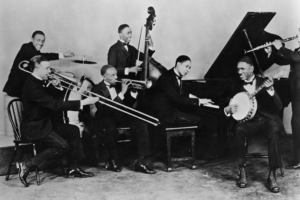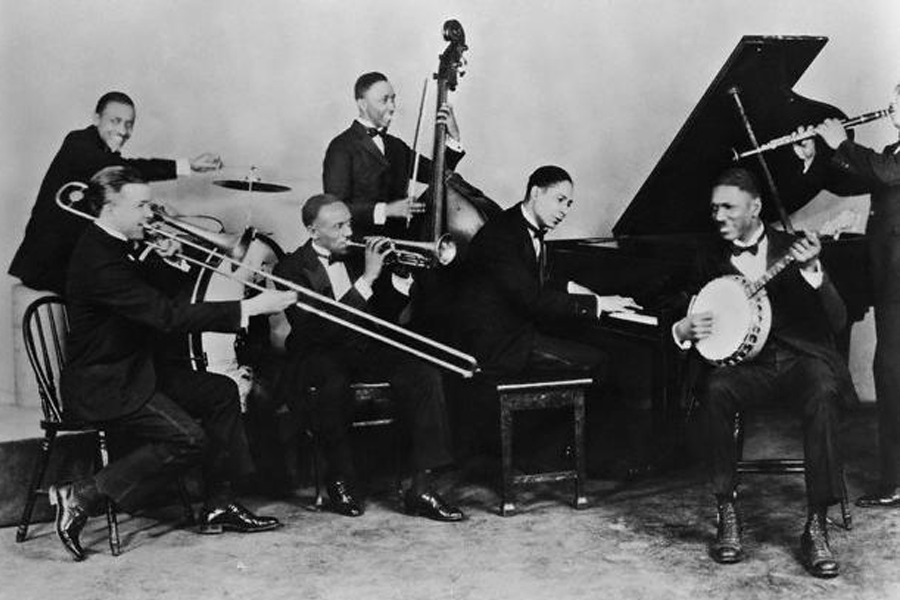
The Beginner’s Guide To Jelly Roll Morton
by
Ron Drotos
My goal in making this Beginner’s Guide To Jelly Roll Morton is to enable you to place his music within the overall context of early jazz in New Orleans, Morton’s overall musical output, and his role in the development of jazz in general. So when you hear a piece of his, you’ll have a greater understanding of him and his music. This will enhance your musical experience both as a listener and as a jazz pianist.
Let’s start at the beginning of the 20th century, when Jelly Roll was 10 years old. (He was born Ferdinand Joseph LaMothe, or LaMenthe, in October, 1890). The musical culture of New Orleans at this time was a rich tapestry of varied styles, from blues and folk music to marching bands, ragtime, and opera. There was also Latin American music coming from the south. It was also a time when classically-trained musicians were coming together with their more self-taught peers to create blends of styles. As a pianist and composer/arranger, Morton played a major role in combining all these elements and transforming them into the exciting new style called jazz.
In 1938, Morton himself gave us an extraordinary account of these times in the series of interviews he did with Alan Lomax from The Library of Congress (see links below). During these 8+ hours of interviews, Jelly Roll told stories, recounted the beginning of jazz, and played piano to illustrate his points. The whole series is worth listening to, and provides a special and invaluable insight into the development of jazz, particularly for the period before 1917 when the first jazz recordings were made.
Morton’s “Jelly Roll Blues” is sometimes considered to be the first jazz composition. It was composed in 1910 and is certainly one of the first, even if there’s no way to verify when exactly jazz was invented and by whom. Here it is, folks, the birth of jazz:
Remember, jazz wasn’t recorded until almost a decade after it’s initial development. This recording is from 1926 and features a full jazz band, even though Jelly Roll probably played it solo most of the time in the beginning.
Notice how complex this music is in all its elements: rhythmically, harmonically, and melodically. The introduction, for example, starts out in one key and ends in another. (It actually begins on a bVI chord, but we don’t know that upon first listen. It stays on the Gb chord for a full 2 measures before abruptly shifting to the tonic key of Bb. This would be surprising even today!) One reason for the extreme sophistication of early jazz is that a lot of it was structurally modeled on marching band music, partly via ragtime which was commonly played by ensembles as well as on solo piano.
Also typical of early jazz was its frequent use of “stop time,” or rhythmic hits punctuated by silences in the rhythm section. In fact, Jelly Roll and others considered this to be an essential feature of jazz, and it’s one thing that distinguished it from ragtime and marches.
Another “essential” feature of early jazz, in Morton’s view, was something known as the “Spanish tinge.” These was music based on South American latin rhythms which came to New Orleans (a port city) through trade with Latin and South America. Dance rhythms based on the tango and other Latin styles were a big part of Morton’s music.
New Orleans Blues is a good example of this:
For me, it’s surprising that an early “jazz” piece called “New Orleans Blues” turns out to be basically a tango! This fact just serves to reinforce the big role that Latin music played in the world of early jazz. In fact, one might make the argument that Latin music’s emphasis on the “and” of beat 2 eventually became the basis of the Charleston rhythm, which practically came to represent so much music of the jazz age of the 1920s! And notice how Morton half-way swings the intro to “New Orleans Blues,” even though it’s a “straight 8ths” piece. He also breaks into a swinging, full-out stride piano style during the last chorus of the tune. This shows us that the relation between “swing” and latin rhythms was very fluid!
In his Library of Congress interviews, Jelly Roll Morton helps us understand the ragtime influence on early jazz by improvising on Scott Joplin’s “Maple Leaf Rag.”
First, listen to Joplin’s written version:
https://www.youtube.com/watch?v=P1894JRqbsc
Now here’s the amazing part: Jelly Roll plays two jazz renditions of the song here, illustrating both the transformation of ragtime into jazz and also how pianists in different geographic regions played in different styles. First, he plays “Maple Leaf Rag” as pianists in Missouri played it. This is the area where Scott Joplin himself was from, and the music is fast and lively. Then, at :56, he shows how it was played in New Orleans. It’s a little slower and laid back, and we can absolutely hear how similar this is to Morton’s own music.
Notice how one of Jelly Roll’s best pieces, “Wolverine Blues,” comes directly out of this musical lineage:
In addition to helping create the jazz idiom itself, one of Jelly Roll’s major contributions was that he showed how fully-orchestrated arrangements could successfully work in jazz. Morton’s music was highly structured, and he incorporated improvised solos within the context of meticulously detailed arrangements. Indeed, there is little difference between his solo piano concept and how he orchestrated for his band, The Red Hot Peppers (great name!).
Here’s a good example of his arranging style; “The Pearls” as played by his Red Hot Peppers:
https://www.youtube.com/watch?v=TXx2hvbiiyk
In addition to its purely musical value, Morton’s music opens a window on the daily life and culture of New Orleans at the time. Listen to “Sidewalk Blues”(1926). Here, Morton and his band use a combination of humor and clever orchestrations to paint a vivid picture of pedestrians encountering a streetcar. The music incorporates improvised solos within an orchestrated framework, and shifts from lively rhythms to hymn-like textures, giving us a big glimpse into everyday life at the time. They must have had a lot of fun recording this one!
https://www.youtube.com/watch?v=TXx2hvbiiyk
One distinguishing feature of Jelly Roll’s piano playing is his use of trombone-like lines, played by his left hand in octaves. This reinforces the fact that he thought “orchestrationally,” even when playing solo piano. We can hear this in “Wolverine Blues,” recorded with a trio of piano, clarinet, and drums. Listen to how Jelly Roll interjects linear octave fills into the basic “stride” left hand pattern:
https://www.youtube.com/watch?v=r5oa-44QDr4
In the 1930s, Jelly Roll Morton and his music fell out of fashion as big bands heralded in the Swing Era. Unlike his fellow New Orleansian Louis Armstrong, Jelly Roll didn’t embrace the new sound of jazz, preferring to stay in the polyphonic tradition of early jazz, which sounded closer to ragtime than the new sounds of the day. Despite this, he continued to have a huge, although often unacknowledged, influence on popular music.
Benny Goodman, the self-proclaimed “King of Swing,” had a gigantic hit with Morton’s composition, “King Porter Stomp.” Sadly, Morton had already sold the publishing rights and didn’t earn any income from this recording:
https://www.youtube.com/watch?v=SMyn8m0k2c4
Still later, in 1953, Ray Charles had an R&B hit with Ahmet Ertugun’s song “Mess Around” which used the bass riff from Morton’s “New Orleans Blues,” which we heard above. By this time, Morton was long deceased and received no credit for the use of this riff, even though it was a featured part of his copyrighted tune. Ray Charles’ recording is a good example of how much Morton influenced early rock and R&B:
It’s now been over a century since Jelly Roll Morton pioneered jazz. His influence can be felt in all areas of popular music; indirectly through the rock and R&B traditions, and directly through contemporary New Orleans-style piano music. Here’s the great New Orleans pianist Dr. John performing Morton’s tune, “Didn’t He Ramble.” He plays much differently than Morton did, but the musical connection is clear.
In retrospect, I find it fascinating that Morton could have updated his music to the “new” swing style if he had chosen to, but he generally preferred to stay true to his mature style that he had so finely crafted. An exception is his rendition of Fats Waller’s “Ain’t Misbehavin’,” which he played for Alan Lomax at the Library of Congress. Jelly Roll was so talented that he could absorb the newer influences and improvise effortlessly in the new style. His rhythmic feel here at times sounds like Waller’s and he easily spins out a flowing melodic improvisation that to my ears sounds more like Earl Hines and Art Tatum than Jelly’s usual style.
Now that you have a good overview of Jelly Roll Morton’s music and his place in the jazz and pop tradition, you’ll be able to recognize his influence when you hear it. I’m so glad he was able, near the end of his life, to record his stories and songs at the distinguished Library of Congress. It was a fitting, although rare, acknowledgement of his important role in the development of jazz while he was still alive. And for us now, it’s a very special window into the world of early jazz and the culture from which it developed. If you have any other favorite recordings of his, please let us know in the comments.
Enjoy the journey, and “let the music flow!”
Ron
To learn more:
Jelly Roll Morton on Wikipedia
Library of Congress recordings
Take your left hand playing to a new level with my free ebook: Left Hand Techniques for Jazz Piano
You’ll also get my weekly jazz newsletter with practice tips and inspiration


I am not a pianist but I play ragtime guitar. I am working on The Pearls. Does it start in G Major and stay there, or is there a modulation to another key? Do you know whether sheet music was published for it?
Hi Patrick – ragtime guitar sounds fascinating. The Pearls modulates up a fourth, to C major near the end. The piano score is in The Collected Piano Music of Jelly Roll Morton by James Dapogny. It’s a great book. Have fun learning it!